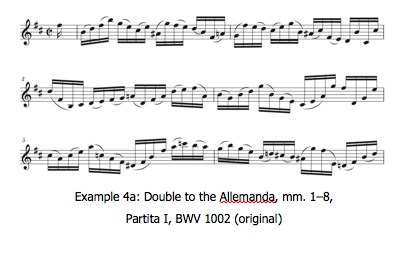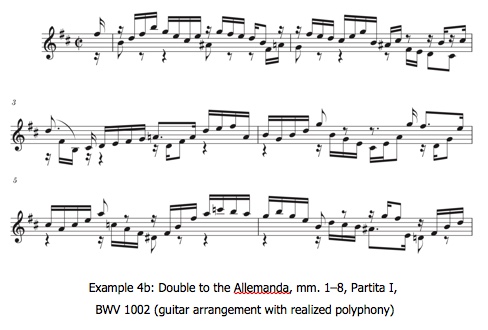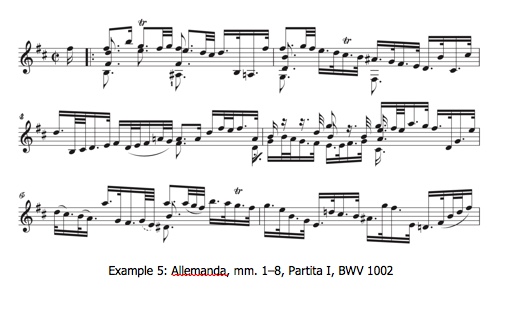The Sonatas and Partitas —An Arranger's Perspective (Part Two)
By: Frank Koonce and Heather DeRome
This is the second part of a three-part article about some of the interesting issues that we encountered while working out our arrangements of the Sonatas and Partitas. As mentioned, all the issues discussed in part-one (linked above) are fairly straight-forward, and if one spends a little time and effort coming to grips with the structure of the music, the answers come with a fair degree of certainty. However, Bach did not write the bulk his solo string music in the same fashion as his keyboard, lute or vocal music, and then choose to omit the occasional note because of a technical constraint. The violin solos are not always full of implied notes. Rather, much of the time, the expected notes are already there, though sometimes in a different octave or on a different beat than anticipated. In his solo string music, Bach, in a sense, invented an entirely new way to compose––interweaving the harmony with the counterpoint. This is perhaps mostly evident in the first Partita, BWV 1002, and especially in the doubles.
For example, compare Bach’s notation for the Double to the B-Minor Allemanda, BWV 1002, to an early draft of our arrangement.


Here is part of our original email exchange that accompanied this draft:
"I'm having a hard time deciding on what to do for the Double. I've started out by trying to put it into two voices, but I don't know if this is the best thing to do for this movement. It is very hard to know where to divide the voices, and there are different possibilities. Therefore, I'm wondering if it would be better to just keep the single voice stemming of the original."
What followed was a debate that spanned several years, with each of us changing viewpoints more than once. Should we keep Bach’s compound-melodic notation or realize the counterpoint (notate it in such a way that the different lines are brought into relief)?
As mentioned in our performance notes and in the part-one article, although Bach’s notation (as in example 4a) appears to the eye as a single line, the music is still heard as a multi-voiced composition. Also in this same example, we see the bowing/phrasing marks in two-note groupings, which strongly suggests the playing of notes inégales.
In our early draft (example 4b), we realized the compound line into two-part polyphony. One nice thing about a score like this is that players are given visual cues pointing to how the different voices flow in and out of one another. However, this immediately raises questions: How many voices are there? Two? Three? Four? And where do the lines divide? There are countless possibilities. And so the drawback of this approach as a final published product is that there are too many subjective decisions to be committed to, which must immediately discount the myriad of other interpretive choices that are available. Still, we exchanged close to a hundred drafts such as this one, as we explored the seemingly endless possibilities. It was equally illuminating to discover what was possible as what was not. For example, now compare our arrangement of the Double, above, to the Allemande itself:

Looking at measure 1, beats 3 and 4, we can see how Bach subtly suggests that the bass line––B, A-Sharp––goes back up to B, before moving to A-Natural. In both the Allemanda and its Double, the motion from A-Sharp back to B is very fleeting, but it serves to avoid having a chromatically descending line––A-Sharp, A-Natural, G––which would not be wrong in any way, but would create a strong rhetorical statement, which Bach seemingly wanted to avoid.

Looking now at our arrangement of the Double (shown again here, to avoid the need to scroll up and down), in measure 1 that fragment A-Sharp, B, A-Natural is made evident because the B (second note of beat-four) is given an eighth value, and thus keeps sounding over the F-Sharp that is heard next. Then there is a rest above the A-Natural. This way, a careful player can connect that portion of the line. However, notice that the A-Sharp and B have different stem directions, which is problematic for a score with realized polyphony. (In compound-melodic notation, stem direction is simply to allow the music to fit on the page, but in polyphonic notation it helps delineate the lines.)
However, at the same passage in the Allemanda, notated in Compound-melodic notation, again there are variances in stem direction, but here the lower line is more visually apparent, because it is also in the lower octave. In early drafts of Allemande also, we addressed the possibility of realizing the lower line, giving it separate downward stems. But then what would we do about all the rests? The B-Natural in the bass (second note of beat 4) is an important note insofar as how we perceive the piece, however it is given a very subtle rhythmic role. In the end, our score would be overly cluttered with rests and complex rhythmic figures and, as mentioned above about committing to one notation, we would have had to disregard too many equally valuable possibilities, if we had used the polyphonic notation.
Considering that the above discussion highlights questions that apply only to the first two measures, one can imagine the wealth of insights that can be gained simply from trying to decide how to notate a passage.
Another problem with our early drafts of the Allemanda’s Double, was that we felt compelled to remove Bach’s slurring. If you think of a slur as a rhetorical gesture, a way to suggest a style of musical oration (rather than, for example, as a phrase slur or as a flourish sweeping up the keyboard), then the notes that are slurred together would apply to the same “speaker” –hence, the same voice. For example, Bach has a slur in measure one, between the first two notes of beat three. In our polyphonic score, those two notes do not appear as a connected gesture. Rather the A-Sharp is part of the bass line and the G is a treble note. The Double is rife with this type of “dual-reality,” if you will, as there is an audible multi-voice texture that is very closely matched to its parent movement, but there is also the Affeckte that is created by the continual bowing in two-note groupings.
This bowing pattern also serves to contrast the Double from the Allemanda itself. On the very surface level, the Allemanda, with its full chords and crisp dotted rhythms is a ballroom dance, whereas the Double with its sprightly back and forth “sawing-type” bowing as they call it, is more suggestive of a fiddler’s barn dance. Within this strong contrast, looking at beat four of measure two in both movements, and assuming that the Double was played with notes inégales, these two beats would sound very similar indeed. There are many such similarities between the two movements, and these were yet other aspects of the music that we experimented with highlighting in our polyphonic-notation scores.
Our decision to abandon the polyphonic notation did not come easily. In the end it came with the hope that players will take the time to apply their skills to discovering for themselves the incredible richness that lies beneath this seemingly simple notation.
The next movements, the Corrente and its Double, present yet another look into the mind of a composer with a seemingly inexhaustible flow of musical ideas, and a continual commitment to challenging both himself as a composer, and the violinists who would be studying his music –and thus, also those of us who take it upon ourselves to arrange his music for a new instrument. These will be discussed in part-three.
Copyright © Koonce/DeRome, 2020.
For example, compare Bach’s notation for the Double to the B-Minor Allemanda, BWV 1002, to an early draft of our arrangement.


Here is part of our original email exchange that accompanied this draft:
"I'm having a hard time deciding on what to do for the Double. I've started out by trying to put it into two voices, but I don't know if this is the best thing to do for this movement. It is very hard to know where to divide the voices, and there are different possibilities. Therefore, I'm wondering if it would be better to just keep the single voice stemming of the original."
What followed was a debate that spanned several years, with each of us changing viewpoints more than once. Should we keep Bach’s compound-melodic notation or realize the counterpoint (notate it in such a way that the different lines are brought into relief)?
As mentioned in our performance notes and in the part-one article, although Bach’s notation (as in example 4a) appears to the eye as a single line, the music is still heard as a multi-voiced composition. Also in this same example, we see the bowing/phrasing marks in two-note groupings, which strongly suggests the playing of notes inégales.
In our early draft (example 4b), we realized the compound line into two-part polyphony. One nice thing about a score like this is that players are given visual cues pointing to how the different voices flow in and out of one another. However, this immediately raises questions: How many voices are there? Two? Three? Four? And where do the lines divide? There are countless possibilities. And so the drawback of this approach as a final published product is that there are too many subjective decisions to be committed to, which must immediately discount the myriad of other interpretive choices that are available. Still, we exchanged close to a hundred drafts such as this one, as we explored the seemingly endless possibilities. It was equally illuminating to discover what was possible as what was not. For example, now compare our arrangement of the Double, above, to the Allemande itself:

Looking at measure 1, beats 3 and 4, we can see how Bach subtly suggests that the bass line––B, A-Sharp––goes back up to B, before moving to A-Natural. In both the Allemanda and its Double, the motion from A-Sharp back to B is very fleeting, but it serves to avoid having a chromatically descending line––A-Sharp, A-Natural, G––which would not be wrong in any way, but would create a strong rhetorical statement, which Bach seemingly wanted to avoid.

Looking now at our arrangement of the Double (shown again here, to avoid the need to scroll up and down), in measure 1 that fragment A-Sharp, B, A-Natural is made evident because the B (second note of beat-four) is given an eighth value, and thus keeps sounding over the F-Sharp that is heard next. Then there is a rest above the A-Natural. This way, a careful player can connect that portion of the line. However, notice that the A-Sharp and B have different stem directions, which is problematic for a score with realized polyphony. (In compound-melodic notation, stem direction is simply to allow the music to fit on the page, but in polyphonic notation it helps delineate the lines.)
However, at the same passage in the Allemanda, notated in Compound-melodic notation, again there are variances in stem direction, but here the lower line is more visually apparent, because it is also in the lower octave. In early drafts of Allemande also, we addressed the possibility of realizing the lower line, giving it separate downward stems. But then what would we do about all the rests? The B-Natural in the bass (second note of beat 4) is an important note insofar as how we perceive the piece, however it is given a very subtle rhythmic role. In the end, our score would be overly cluttered with rests and complex rhythmic figures and, as mentioned above about committing to one notation, we would have had to disregard too many equally valuable possibilities, if we had used the polyphonic notation.
Considering that the above discussion highlights questions that apply only to the first two measures, one can imagine the wealth of insights that can be gained simply from trying to decide how to notate a passage.
Another problem with our early drafts of the Allemanda’s Double, was that we felt compelled to remove Bach’s slurring. If you think of a slur as a rhetorical gesture, a way to suggest a style of musical oration (rather than, for example, as a phrase slur or as a flourish sweeping up the keyboard), then the notes that are slurred together would apply to the same “speaker” –hence, the same voice. For example, Bach has a slur in measure one, between the first two notes of beat three. In our polyphonic score, those two notes do not appear as a connected gesture. Rather the A-Sharp is part of the bass line and the G is a treble note. The Double is rife with this type of “dual-reality,” if you will, as there is an audible multi-voice texture that is very closely matched to its parent movement, but there is also the Affeckte that is created by the continual bowing in two-note groupings.
This bowing pattern also serves to contrast the Double from the Allemanda itself. On the very surface level, the Allemanda, with its full chords and crisp dotted rhythms is a ballroom dance, whereas the Double with its sprightly back and forth “sawing-type” bowing as they call it, is more suggestive of a fiddler’s barn dance. Within this strong contrast, looking at beat four of measure two in both movements, and assuming that the Double was played with notes inégales, these two beats would sound very similar indeed. There are many such similarities between the two movements, and these were yet other aspects of the music that we experimented with highlighting in our polyphonic-notation scores.
Our decision to abandon the polyphonic notation did not come easily. In the end it came with the hope that players will take the time to apply their skills to discovering for themselves the incredible richness that lies beneath this seemingly simple notation.
The next movements, the Corrente and its Double, present yet another look into the mind of a composer with a seemingly inexhaustible flow of musical ideas, and a continual commitment to challenging both himself as a composer, and the violinists who would be studying his music –and thus, also those of us who take it upon ourselves to arrange his music for a new instrument. These will be discussed in part-three.
Copyright © Koonce/DeRome, 2020.

 Videos
Videos Articles
Articles The Sonatas and Partitas —An Arranger's Perspective (Part Two)
The Sonatas and Partitas —An Arranger's Perspective (Part Two)